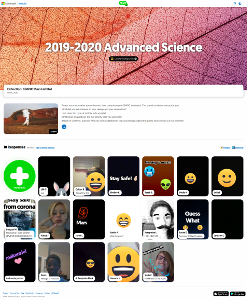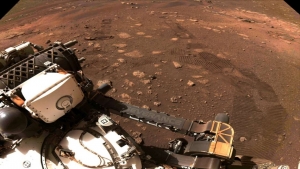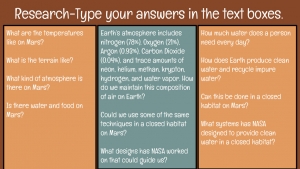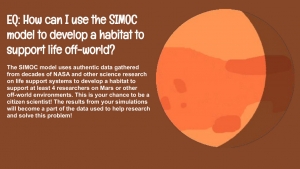February 6, 2021
When COVID-19 turned the whole world upside down in the Winter of 2020, teachers around the world had to instantly redesign their entire curriculum to fit the needs of their students. During this time, I was fortunate enough to have the opportunity to beta test the SIMOC habitat simulator with my students. I had a decision to make: Do I “survive” the rest of the school year using digital worksheets and Google Meet lectures, or do I take a risk and integrate this cool tool in our learning? The fact is, I love integrating technology into my lessons, so my students were well prepared for at-home learning. We needed a new challenge and the SIMOC model was a perfect fit for us!
At that time I was teaching 6th and 7th grade science. In Georgia, 6th grade focuses primarily on Earth and Space Science while the 7th grade content is Life Science. I was so excited because I could easily connect the design of a human habitat on Mars to the standards of both grade levels. I took advantage of the already developed SIMOC curricula and adapted it for my online learners. I basically condensed a good deal of the information in a Google Slideshow for my students, so they could independently progress through the simulation and activities on their own. Ultimately they were expected to research the conditions on Mars, consider the necessities for survival, design a habitat (2D or 3D), run the simulations multiple times adjusting as needed, and reflect on their findings.
I made specific connections to the previous learning we had done on topics such as overpopulation, the need for sustainable solutions for pollution, renewable vs. nonrenewable resources, and the requirements to sustain life with connections to the atmosphere on Mars vs. the atmosphere on Earth. I engaged them in thinking about what would be needed to realistically live on Mars. We talked about all of the population and sustainability problems we explored throughout the year and identified that one solution could be to inhabit Mars. From that point forward, students were researching, designing a habitat, and testing their ideas. They had to consider the cost to transport materials to Mars, how many humans could be supported, what would they grow to eat, how much space they would need, and also account for the mental health of the inhabitants among other things. This was much more beneficial than a Google Meet lecture and a digital worksheet! This was authentic citizen science because the data from their simulations could be used to benefit the collective good, and the students loved it! They benefited so much from researching the problem, exploring solutions, designing a habitat, and testing it out in SIMOC. They adjusted their designs and saw the results in the simulation.
Overall, I found the use of SIMOC with my students during digital learning to be incredibly beneficial and a true problem solving activity that encouraged students to see how our choices now can result in challenging decisions in the future. How amazing is it that we could pull this off during digital learning at the end of the school year in a worldwide pandemic?
Fast forward to Winter of 2021. I now teach 8th grade Physical Science and High School Physical Science at a new school in our system. Yet again, SIMOC is easily integrated into my curriculum. This time I was able to use SIMOC with students both in person and online, as our students have the choice to participate through digital or in-person learning. I reach all of them at the same time by using Google Meet to broadcast our classroom to the students at home. This year I decided to take a different approach.
 Watch a series of video presentations made by Gretchen’s students, as they present their homework assignments from home-bound studies in a virtual classroom.
Watch a series of video presentations made by Gretchen’s students, as they present their homework assignments from home-bound studies in a virtual classroom.
Download Gretchen’s student engagement slides: PowerPoint | PDF
Of course I still connected the same concepts mentioned above because these are ongoing issues no matter their grade level; however, I chose to have students discuss atmospheric density and the behavior of gases on Mars, as my High School Physical Science students were learning about ideal gas laws at the time. This was a new way for me to engage the students in the design of the perfect Mars habitat as they now had a more developed understanding of the challenges. In addition to this, with Mars Perseverance landing on February 18th, this was the perfect time to discuss how our research and experiments now help to provide opportunities for humans in the future. In fact, Mars Perseverance was what I used to first engage the students, and we talked about privately funded aerospace programs such as SpaceX and Blue Origin. We then we transitioned into discussions of the challenges not just with space travel but with creating a sustainable habitat on Mars. My favorite part of the discussion was when we talked about how this work is for the greater good and how sometimes the work we do now is not necessarily for our own benefit but to benefit others, and thanks to those before us who laid the groundwork to provide these opportunities for us now. So although we haven’t gone through the whole process of researching and designing a habitat yet this year, we have used our prior knowledge to make connections and run simulations to celebrate Mars Perseverance and learn about how it takes a collective effort to make progress!
Thank you for this amazing resource and the opportunity to share our experiences! I teach some of the same students this year that I had last year, and they were thrilled when I pulled up our examples from last year that are featured on the SIMOC site. They were so happy and proud to show their new classmates what they had designed and tested! Below are some of my favorite quotes from running our simulations this year. Students were excitedly announcing their progress (quotes below), and it warmed my heart to see them so excited about science! They were begging to take turns to come up to the board and run a simulation for the class. It was awesome to do this in person as opposed to just virtually last year. I could actually see the excitement in their faces!
“Yay! My person survived 99 days and 23 hours!”
“We’ve been on Mars for a year!”
“I don’t have much oxygen left, so I need to figure that out!”
“My simulation is weird. I have 10 people in a small space for 365 days. They are dying fast. Actually they are fully dead now. They lasted 72 days.”
“Oooh! Their energy is going up! Look at that!”
“Oh no, there’s not enough power! It must be nighttime.”
“Their food! Oh no! But I did the math!”
June 6, 2022
Gretchen engaged her English class to build a mathematical model of carbon dioxide levels given two students sealed inside of a Mars habitat analog, built by the students from cardboard, tape, and paint. In conjunction with this project, Gretchen received an early prototype for the SIMOC Live air quality monitor and successfully deployed this as a means to measure the CO2 levels. Read the full story with these blog entries posted on the SIMOC website:
A Mars habitat analog in the classroom?! followed by A Mars habitat analog in the classroom?! –update
Read the full paper for ICES 2021 | Read the feature article at NSTA | Gretchen’s Website




